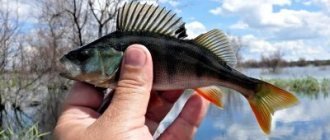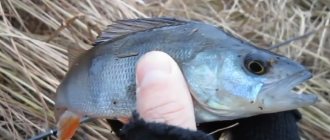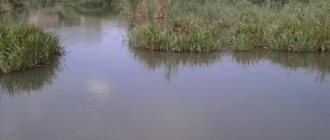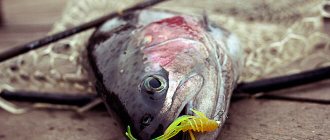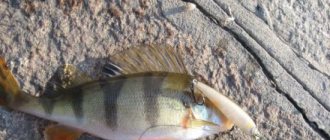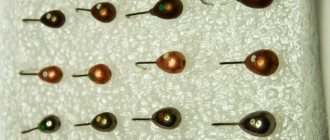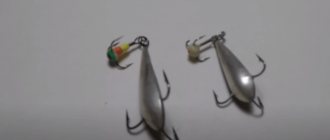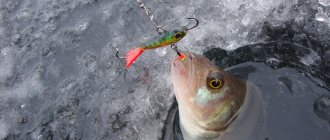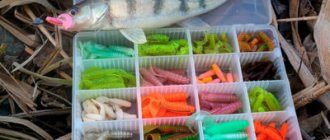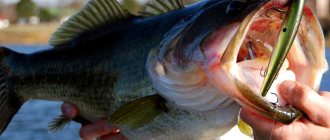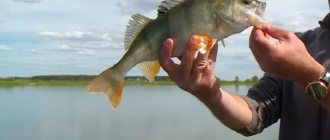Installation features
Installation of the bait occurs without much effort and complexity; there are many options for equipment - Carolina, Texas, drop-shot, combination of twister with Cheburashka and others. Each technique is suitable for certain situations and works in different conditions, at different levels of the water horizon, swampiness of the reservoir and flow speed.
The color of the bait also plays a role in the success of fishing.
The choice of the desired twister shade is influenced by:
- great depth (all bright, acidic and neon tones);
- bright sunlight (natural dark colors, black, blue, brown);
- cloudy weather and twilight (light beige, gold, yellow, beige tones);
- muddy water (unnatural combinations and bright colors).
Types of twisters for perch When fishing for perch with a twister, the most successful color combination is considered to be red and white with a clear separation.
The use of red in bait when hunting a striped predator is always desirable, regardless of external conditions - the fastidious predator reacts very actively to it. Successful use of a twister when hunting perch is possible throughout the open water season. On rivers with a noticeable current, its use is successful at the boundaries of creeks and strong flows; in stagnant bodies of water, it is better to fish near areas overgrown with algae with a tinned bottom. The rangers at our base will tell you the most fishing spots and help you prepare the necessary and suitable equipment for fishing.
Twister characteristics
3.1 Form
The structure of a twister resembles a worm. The tail is flat and consists of a long, rounded tail. Rings are carved along the length of the abdomen; in some models other elements may be provided. The peculiarity of such an ornate body is its ability to be mobile under any fishing conditions, and if equipped with a floating head and a firefly, then you can fish on the surface of a reservoir, in muddy water and at any depth. Many people use this bait as an additional element to spinners (oscillating or rotating).
The shapes of twisters are varied: wide and narrow, ribbed and smooth, two-tailed, short and long. The play and behavior of this rubber depends solely on the shape of the tail and the softness of the material.
3.2 Material
Twister can be made of soft plastic and various polymer materials. The most common and desired material is silicone, and each manufacturer uses its own secret recipe when making baits.
3.3 Size
Size range – from 1 to 30 cm.
What sizes and what to use:
- Microjig - size 1 - 2 inches;
- Trolling + heavy jig heads - from 4 inches.
- Large sizes for catching saltwater fish and catfish in freshwater bodies.
Average size tires are considered to be 2.5 - 4 inches.
Below is a table for converting inches to centimeters
When choosing a size, you should be guided by the following:
- determine the type of desired production;
- resolve the issue of casting range;
- determine the strength of the current.
Based on these characteristics, the necessary size selection is made for a specific fishing trip.
3.4 Color of silicone lures
Conditions for choosing the color of silicone baits:
- water condition of the reservoir;
- seasonality;
- time of day of fishing;
- weather.
What colors to use and under what conditions:
- muddy water - bright colors;
- cold and clear water – from blue to purple;
- clear water – calm (natural) shades (green, milky with white, transparent brown);
- clear water and sun - bright colors;
- muddy water and bright day - bright baits, for example pink;
- cloudy days – black, blue, red colors.
The yellow color of silicone baits, according to many anglers, is considered universal in the color scheme of twisters. Do not forget that the choice in favor of one shade or another is made by the fisherman experimentally.
Types of marine fish and colors:
- perch – black and brown colors;
- cod – black and brown colors;
- sea bass – white, gray colors;
- squirrel fish - dark colors;
- barracuda - dark shades.
Do you want to see how the color of silicone baits changes underwater? Then watch this fascinating video (Fishing PRO)
Twister for perch on a retractable leash
It is recommended to catch this cunning and nimble river predator using diverting leashes with attached twisters.
The process of installing leashes is quite simple:
- the end of the fishing line is secured with a sinker;
- at a short distance (10-15 cm), two loops are tied on the fishing line;
- a medium-length leash (up to 30 cm) is tied to each loop;
- Each leash is equipped with a hook and a twister.
You should not make leashes that are too long, as this will complicate control.
A similar equipment is used when pulling a load along the bottom; accordingly, the twister must be selected taking into account the possible turbidity of the water and great depth. When fishing in a reservoir with a noticeable current, the load on the line must be weighty enough so that it is not carried away by the flow.
Installation of fishing gear on a retractable leash The principle of operation of the bait is that the mud raised by a load from the bottom attracts a perch, which, when approaching, notices the twister and attacks it.
This method is considered very successful; the catch is significant, since several fish can be caught at once.
How to catch perch with a twister?
Bass can be caught on almost any moving or stationary bait that flashes or wags its tail.
- How to fish? ↓ Selecting a Twister ↓ Assembling the bait ↓ Installation on a free hook ↓ Installation on a free hook ↓ Throw ↓ Jig head ↓ Tenon head ↓ Tenon head ↓ Cheburashka ↓ Carolina tackle ↓ Attachment to a double hook ↓ ↓ Blitz tips ↓
The Twister is ideal for catching these fish. This bait consists of a silicone body ranging from 1 to 30 cm in length with a crescent-shaped tail on the back. When rotated quickly, the tail section vibrates, causing the bass to be more interested in chasing and swallowing.
The twister is not used alone when fishing, but is attached to an offset hook or jig head, which must be proportional to the bait.
How to catch?
Catching a striped predator with a twister is very productive in the warm season, but even during this period the perch’s appetite is significantly reduced, and this fish is very passive and lethargic.
To attract inactive bass, bait should be baited at a slower pace and with long pauses. Eating edible chewing gum with a delicious smell can also create the strongest appetite in this fish.
You can add flavoring yourself, for this you need:
Rinse the bait thoroughly. Place in a plastic bag. Add the flavoring and knead the bag thoroughly with your hands so that the flavoring is evenly distributed over the surface of the bait. The rubber bait should be kept in a tightly closed bag for several days. After this treatment, the bait will emit a pleasant aroma for the perch for a long time, and the number of bites from this fish will increase significantly. The most attractive scents for catching striped predators are attractants with the smell of shrimp and fresh fish. In the spring, perch go crazy for smelt.
In the upper layer of water you can catch small perches. For this, a mini-twister is used, which is passed along a uniform cable along the surface of the tank. Clamping is carried out on an offset hook without a load.
Twister selection
For catching perch, this bait is chosen to be small in size. The length should not exceed 5 centimeters. Of course, when using larger bait, bites will be no less frequent, but the wiring efficiency is too high. A silicone twister for bass fishing will be very low and the durability of this product will be significantly reduced.
The color of the twister may vary under normal fishing conditions. If you are fishing for perch in poor visibility conditions or if the water in the aquarium is too cloudy, the twister uses only bright colors.
Mounting the bait
There are a huge number of ways to assemble this bait, and due to the simple design of the bait, the possibility of experimentation increases many times over.
Among the most popular assembly tool twisters, it is worth highlighting the following:
Non-snacking hook mounting
This structure allows you to fish very rich coastal areas of the reservoir, overgrown with vegetation. In this option for installing the bait, its body is pulled over the hook, the sting is brought out in the center, and the tail remains in “free floating.”
The striped predator does not swallow prey too much, but makes grasping movements, so if the bait is used for too long, the hook will not catch and the perch will remain free, sometimes with a part of the gum bitten off in its mouth.
Drop shot
Fishing gear that allows you to fish in crowded places with strong currents.
Installation of the bait is carried out as follows:
The main line is equipped with a weight, the weight of which depends on the current strength in this zone of the tank. At a distance of 20 - 30 cm from the load, put on an offset hook and thread the twister onto it. This simple fastening design allows for long casts, and wiring, even in dangerous places, is completely safe for the integrity of the kit.
Jig head
A very popular equipment for fishing with silicone baits. This is the sinker into which the hook is recessed. The size, weight and hook size are very different. The size of the sinker depends primarily on the presence and strength of the current, and the size of the hook depends on the size of the rubber bait used.
Cheburashka
This method of attaching a twister is more universal and, unlike a jig head, can be easily equipped with hooks of different sizes. To do this, 2 “grabs” are mounted on the lifting load, one of them is equipped with a reach-out hook of the required size, and a fishing line is tied to the other.
Carolina rig
This method of attaching silicone has been known for a long time. The homeland of the Carolina rigging is America, where fishing with all kinds of tire changes is very popular.
Installation occurs in this order:
A weighting device is installed on the main line, at a distance of 1 meter from the shore. The weight must be attached so that it does not move along the fishing line. An offset hook is attached to the end of the fishing line, onto which a twister of the appropriate size is attached.
Wiring a twister for a perch
The method of applicable wiring of the twister is subject to the level of activity of the predator and the general environmental conditions - the speed and strength of the flow, the water content of the reservoir, the topography of the bottom. Fast and nimble perch responds better to fast and gusty movements. Lazy and slow fish, on the contrary, need smooth movements with stops and pauses of uniform movements. When there are noticeable differences in water horizons and an uneven bottom surface, stepped fishing is used in fishing. In conditions of shallow depths and a flat bottom, uniform wiring is used.
Garland for perch made from twisters
It is also called drag. Suitable for any equipment, the only wish is that the length of the rod is at least 270 cm. A cambric is attached to the fishing line near the end, the edge of which is placed on the loop of a drop-shaped weight. Then, with a slight indentation from the load, from two to four leashes 5-6 cm long are attached to the fishing line, which are equipped with hooks and twisters. The method of attaching leashes is arbitrary.
In online stores you can find ready-made tracks with up to 5 leashes.
When fishing with a garland, it is best to use a uniform retrieve, although some fishermen prefer a jig.
How to choose a twister?
When going fishing, it is best to take several different baits. This way the chances of getting a good catch will be much greater. If you plan to catch perch with a twister, then experienced fishermen recommend limiting yourself to samples no longer than 5 cm. As for the color, it is selected depending on the weather. A shiny fish playing in the rays of light is ideal for a sunny day. It can be either gold, white or orange with shiny splashes. When going fishing in cloudy weather, choose red or black bait. Bright twisters are more suitable for ponds with muddy water.
When fishing with such a bait as a sinker, you need to equip it with a jig head, which is designed to perform the function of a sinker. For reservoirs with stagnant water, its weight can reach 15 g; when fishing on stormy rivers, it can be increased to 25 g.
When choosing bait, you should pay attention to the manufacturer’s brand. The best twisters for perch, according to surveys, are produced under the following brands:
- Relax;
- Manns;
- Bass Assassin Curly Shads.
General recommendations for catching perch
- To catch a large specimen, it is better to go fishing in the early morning or late evening; during the day, large fish hide in hard-to-reach places.
- When using a twister, it is better to take the lightest possible rod, since both the bait and the fish itself do not have much weight.
- At night, due to the peculiar appearance of the bait, it will not be possible to catch a perch with it - despite the bright colors, the fish simply will not see the twister.
- Perch lives and hunts in schools, which plays into the hands of the fisherman when using a twister. Even if the first bite fails, do not rush to stop the retrieve, as another fish may bite immediately after the first one.
- When tracking a perch, watch the fry - as soon as the small fish begin to actively swim away and “scatter”, then you should immediately cast to this place, with a high probability our striped predator is feeding there.
- The fishing line for perch should be quite thin, but at the same time very strong, capable of withstanding significant loads and sudden jerks.
- If the current is strong, increase the weight of the sinker or use a heavy jig head.
Don’t forget to visit the Sazanya Bukhta fishing base, where you can catch excellent Astrakhan perch.
TAGS:
Secrets of perch hunting
- The best time to catch “striped” fish with a twister is dawn. It is at this time that there is a good opportunity to catch a trophy predator. In the evening, active biting is also possible.
- Catching perch at night is almost impossible.
- Perch prefers a schooling lifestyle. Therefore, you should not stop wiring if one predator chased the bait, tried edible silicone and did not attack it. Often, a hungrier bass can react almost immediately.
- The best spoons for pike
- The best silicone crustaceans: TOP 5
- Bait Breath SL-Remix: detailed review
- Wires for catching pike perch using silicone
Tags
Carp Buffalo Spring Vobla Asp Winter Crucian Rudd Summer Fishing baits Lower Volga Perch Autumn Fisherman's reminder Lures Bite forecast Fishing in Astrakhan Fishing baits Fishing tackle Fishing secrets Catfish Fishing methods Pike perch Catch Pike
